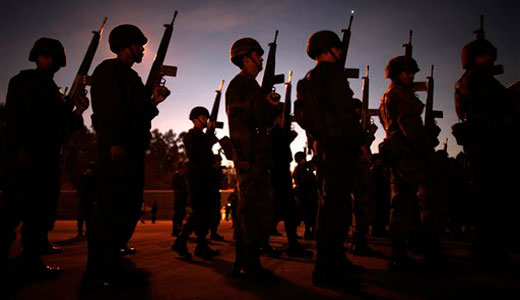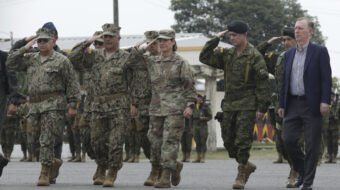
MEXICO CITY – Five years after President Felipe Calderon sent soldiers into cities and towns across the country to dismantle drug cartels, Calderon is still far from achieving his goal. Instead, it appears the Mexican government has lost control of the situation and turned the country into a battlefield.
Not a day passes without the country’s newspapers and television news networks mentioning the latest casualties, deaths and battles. Every day bodies are found, often with signs of torture. The drug cartels are waging a brutal war against government security forces and rival cartels to control lucrative drug exports to the United States. The cartels make between $18 – $39 billion in drug profits each year, according to official estimates.
Women become victims of sex trafficking
Some of the cartels are also involved in trafficking women and make as much profit from this as the sale of drugs, according to the U.S.-based Council on Hemispheric Affairs. They usually kidnap or blackmail young Mexican women, forcing them to work in Mexican or U.S. brothels or strip clubs.
One of the favored tactics used by the cartels is to leave decapitated bodies or body parts such as severed heads or arms in public spaces to terrorize security forces, rivals and the public. There have been ongoing reports of mass graves being uncovered throughout Mexico.
Mexican soldiers often cover their faces to hide their identities during operations, fearful that the “narcos” will discover their names and send gunmen to kill their families. Two years ago, the names of two soldiers who died in a shoot out with narco leaders in Guadalajara were revealed by news media. The next day gunmen showed up at the doorsteps of the dead soldiers’ family homes and killed most of their family members.
Estimates of the number of deaths range from 50,000 to 67,000 over the last five years. These figures do not include the thousands of people who have disappeared across Mexico and never been heard from again.
So far, the armed forces, while killing or arresting many key figures belonging to the country’s five main cartels, have been unable to destroy Mexico’s principal narco organizations.
Government suspected of ties to cartels
Some critics also charge that the Calderon government has ties with some of the cartels, to which they are providing protection.
The only safe place in the country where there is no fighting is the Federal District, a large state that encompasses Mexico City. Cartel and government leaders, who live in the FD and do not want a bloody war in their backyard, appear to have called a truce.
Human rights advocates also charge that security forces, in the process of battling the cartels, have committed human rights abuses against the civilian population as well as human rights activists. Complaints to state and national human rights commissions have sky rocketed as victims complain of harassment, theft, torture, rape and illegal confinement at the hands of military and police forces.
Profiting from drug trade
According to economist and investigator Olga Rivera Barragan from the Intercultural Indigenous University of Michoacan, the cartels play a big role in the Mexican economy. Drug profits are one of the top sources of foreign exchange for the economy. The cartels employ hundreds of thousands of men and women and pay high wages in a low-wage economy with high unemployment. Mexican banks also launder drug profits for international cartels.
“Working for drug cartels has become a normal activity among many families,” said Barragan. She warns that Mexico “is in a state of social decomposition.”
The drug cartels have been able to count on U.S. government support as well. According to a Dec. 11, 2011 article in the New York Times, the U.S. Drug Enforcement Agency has been washing millions of dollars of Mexican drug money for the cartels, as well as transporting drug profits back and forth from Mexico to the U.S. over the last several years. They have also been depositing money into banks accounts of cartel officials. The DEA claims they have been doing this to obtain intelligence information on the cartels. One anonymous DEA official, when asked how much money the organization was laundering, would only say “a lot.”
The U.S. Bureau of Alcohol, Tobacco, Firearms and Explosives, under a program called “Fast and Furious,” allowed smugglers to buy and sell U.S.-made modern armaments to the cartels. These revelations have caused shockwaves in Mexico.
Source links drug war to neoliberal economic policies
A source in Mexico’s military intelligence services said in an interview, “Calderon initiated the war against the cartels to legitimize his presidency.” Calderon gained power through electoral fraud in 2006 over left-wing rival Andres Lopez Obrador. Many Mexicans do not believe that Calderon is their legitimate president.
The source said Calderon never knew the magnitude of the power of the drug cartels. He has surrounded himself with advisors who are not very astute. The drug cartels are powerful economic and military players in Mexico. They have powerful private armies with thousands of well-trained and well-led men with the latest weaponry and telecommunications equipment, often times better than that of the Mexican army.
Last year the Mexican army discovered that ex-soldiers from the Guatemalan army were training recruits for the Zeta Cartel. The cartels have also been able to recruit ex-soldiers and officers from the Mexican army. Cartels have infiltrated all levels of government, political parties as well as military and police forces, said the source.
Neo-liberalism, championed by Calderon’s National Action Party (PAN) government, has also allowed the cartels to thrive, remarked the source. Neo-conservative policies promoting low wages and high unemployment have made working for the cartels an attractive source of employment. The cartels offer their workers much higher wages than in the formal and informal economies.
“To counter the drug cartels, it is necessary to change the economic model in Mexico,” said the source.
The source said that there are links between the Sinaloa cartel led by Joaquin El Chapo Guzman and the Calderon government. Calderon has gone out of his way to protect the Sinaloa Cartel while targeting the other cartels.
A conflict between the armed forces and the Calderon government over how to deal with the cartels exists, the source continued. “The military wants to kill the narcos. They believe it is too dangerous to put them in jail and try to rehabilitate them.” The Calderon government cannot endorse this strategy because it would risk international condemnation. The source said the army has formed death squads to eliminate the cartels, increasing casualties.
The Calderon government knows what the military is doing but has turned a blind eye. The source estimates at least 80,000 have died over the last 5 years.
Photo: In this June 15, 2009 file photo, soldiers stand in line as they prepare to board vehicles at the Military School in Mexico City to be deployed to the northern part of Mexico to participate in drug crop eradication duties and to learn first-hand Mexico’s ongoing war against the drug cartels. Five years after President Felipe Calderon launched his assault on organized crime, about 45,000 troops have been deployed, plus several thousand more from the Navy infantry, or marines. More than 45,000 people have been killed by several counts, though the government stopped giving figures on drug war dead when they hit nearly 35,000 a year ago. Still, the flow of drugs continues unabated into the U.S. while arms and money flow into Mexico. (AP/Dario Lopez-Mills)












Comments